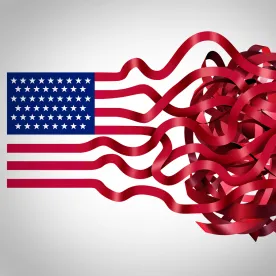Following recent efforts by Democrats to push for “Buy American” action, on January 9, 2018, Senator Chris Murphy (D-CT) proudly announced via Twitter that there now is “bipartisan support for strengthening our Buy American laws” and that he is “excited to have the Trump admin[istration] and partners like [Senators Rob Portman (R-OH), Lindsey Graham (R-SC) and Sherrod Brown (D-OH)] working together to get this done.” That same day, these senators reached across the aisle to sponsor the BuyAmerican.gov Act of 2018 (S.2284) to “strengthen Buy American requirements.”
This proposed legislation may be the most significant “Buy American” development since President Donald J. Trump issued his “Buy American” Executive Order(E.O. 13788, April 2017), which set forth a policy and action plan to “maximize . . . the use of goods, products and materials produced in the United States” through federal procurements and federal financial assistance awards to “support the American manufacturing and defense industrial bases” (and which we analyzed in a prior blog post).
Key Components of The Proposed BuyAmerican.gov Act of 2018
On January 9, 2018, Senators Murphy, Brown, Portman and Graham co-sponsored the bipartisan BuyAmerican.gov Act of 2018 (S.2284). This bill aims to “strengthen Buy American requirements” through three major action areas – two of which heavily borrow from President Trump’s “Buy American” Executive Order. This bill covers multiple domestic preference statutes, including the Buy American Act, the Berry Amendment and the Federal Transit Administration’s Buy America provision (also known as the “Buy America Act”).
1. Formal Recognition of President Trump’s “Buy American” Policy (Section 3)
Section 3 of the bill would codify key policy components of the “Buy American” Executive Order – namely, that:
- “every executive agency should maximize . . . the use of goods, products, and materials produced in the United States” under federal procurements and federal financial assistance awards; and
- “every executive agency should scrupulously monitor, enforce, and comply with Buy American Laws, to the extent they apply, and minimize the use of waivers.”(Emphasis added).
Section 8 of the bill recognizes that this policy still would need to “be applied in a manner consistent with United States obligations under international agreements,” e.g., free trade agreements and the World Trade Organization Agreement on Government Procurement (“WTO GPA”) as covered under the Trade Agreements Act;
2. “Buy American” Reports and Assessments (Sections 4 and 5)Sections 4 and 5 of the bill would require the Executive branch to issue various reports
- Government-Wide “Buy American” Report
The Commerce Secretary would “submit to Congress and the President a report on the implementation of, and compliance with, Buy American laws.” This report would include: (a) information about each agency’s “monitoring of, enforcement of, implementation of, and compliance with Buy American Laws,” (b) information about and related to any waivers/exceptions used by each agency, and (c) “recommendations for policies” to “ensure that, to the extent permitted by law, Federal financial assistance awards and Federal contacts maximize the use of goods, products, and materials mined, produced, and manufactured in the United States, including manufactured products, components of manufactured products, and materials such as steel, iron, aluminum, and cement and services.”
This report must be submitted within 180 days after the bill is enacted and annually for two years thereafter.
- Agency-Level “Buy American” Reports
Each agency would submit a “Buy American” report to the Commerce Secretary and the OMB Director. The agency-level and government-wide “Buy American” reports would cover the same topics.
These reports must be submitted within 180 days after the bill is signed and annually for two years thereafter.
- “Buy American” Waiver Assessment and Policy Guidance
The Commerce Secretary and OMB Director would issue guidance to agencies about “how to make the required waiver assessments and develop the policies” discussed above.
The guidance must be submitted within 60 days after the bill is signed.
- Free Trade Agreement Assessment
The Commerce Secretary and U.S. Trade Representative would “assess the impacts of all United States free trade agreements and the World Trade Organization Agreement on Government Procurement on the operation of Buy American Laws, including their impacts on the implementation of domestic procurement preferences.”
This assessment must be made within 150 days after passage of the legislation.
These reporting requirements essentially are the same requirements found in Section 3 of the Administration’s “Buy American” Executive Order.
3. Limiting the Use of “Buy American” Waivers/Exceptions and Increasing Transparency (Sections 6 and 7)
Borrowing heavily from Section 4 of the “Buy American” Executive Order, Section 6 of the bill provides that “public interest waivers from Buy American Laws shall be construed to ensure the maximum utilization of goods, products, and materials produced in the United States.” (Emphasis added). It also would restrict public interest waiver authority to the “head of the agency with the authority over the Federal financial assistance award or Federal procurement under consideration,” and would require waiver determinations to consider whether the “cost advantage” of the foreign product is the result of dumping, the use of subsidized items or the use of items that enter the U.S. in violation of U.S. customs law.
Section 7 of the bill would implement certain requirements geared towards increasing “transparency” regarding the use of “Buy American” waivers/exceptions:
- Establishment of BuyAmerica.gov
Within one year after the bill is enacted, the General Services Administration would be required to establish a public website (BuyAmerican.gov) that would provide information about “all waivers of and exceptions to Buy American laws that have been requested, are under consideration, or have been granted by executive agencies and be designed to enable manufacturers and other interested parties to easily identify waivers.”
- “Waiver Transparency and Streamlining”
The bill prescribes specific requirements regarding the types of information needed to “adequately document and justify the statutory basis cited for the requested waiver,” including “a certification that the procurement official or assistance recipient made a good faith effort to solicit bids for domestic products supported by terms included in requests for proposals, contracts, and communications with the prime contractor.” Additionally, no agency would be permitted to approve a “Buy American” waiver unless the waiver request (and certain information regarding the request) was made publicly available and an opportunity for public comment was provided within certain time period
Senator Murphy previously introduced these features in his 21st Century Buy American Act (S.2196, Dec. 6, 2017).
Key Takeaways
Does the bill seek to reduce the number of “Buy American” waivers/exceptions that are granted?
It is apparent from the plain language in Sections 4 and 5 of the bill that the sponsors desire to reduce the number of “Buy American” waivers/exceptions granted by agencies. Section 4 of the bill states that “public interest waivers” should be used “judiciously.” And although Section 5 frames the discussion about waivers/exceptions in terms of “transparency,” it still is premised on a stated policy to “minimize the use of waivers.”
The January 9, 2018 press release about the legislation confirms our understanding and interpretation. The press release notes generally that “[t]here is currently no government-wide system tracking the use and abuse of these waivers by federal agencies.” (Emphasis added). Senator Graham stated that “bring[ing] transparencyto the process” should “bring a much-need system of checks-and-balances to the current waiver process,” and that “manufacturers . . . across the United States” should be “prioritized when it comes to the bidding and awarding of contracts.” (Emphasis added). In this context, terms like “checks-and-balances,” “transparency,” and “prioritized” appear to be code for increasing scrutiny and reducing the number of waivers/exceptions.
Will U.S. manufacturers actually benefit from increased scrutiny over “Buy American” exceptions/waivers
The press release about the bill stated that the new BuyAmerica.gov website would “allow manufacturers and other interested parties to identify contract opportunities and hold federal agencies accountable for abusing Buy American waivers.” Senator Portman added that “[b]y improving transparency, the BuyAmerican.gov Act will encourage federal agencies to support American workers and American jobs by faithfully complying with Buy American law.”
We agree that increased scrutiny over “Buy American” waivers likely will present some new opportunities for contractors. For example, an agency may shy away from utilizing a waiver to obtain a foreign item, and instead seek out domestic items. At the same time, a contractor may gain important insights from the BuyAmerica.gov website that may allow it to challenge an agency’s use of a waiver, or to identify opportunities to manufacture items that currently are not available domestically.
However, the number of opportunities that actually may arise for U.S. manufacturers as a result of this increased scrutiny remains to be seen. For example, according to recent DoD reports submitted to Congress regarding purchases from foreign entities, DoD issued only 34 “public interest exceptions” (in the amount of $570,467) in FY 2016 and 31 “public interest exceptions” (in the amount of $623,165) in FY 2015. Thus, at least for DoD, there does not appear to be a significant number of “public interest exceptions” being granted. By contrast, DoD “authorized waivers pursuant to MOUs, the TAA or other international agreements” that led to “20,126 purchases totaling approximately $1.3 billion” in FY 2016 and “9,686 purchases totaling approximately $653.4 million” in FY 2015. Because Section 8 of the bill indicates that the bill “shall be applied in a manner consistent with United States obligations under international agreements,” it is unlikely that the Trade Agreements Act waiver (which permits agencies to procure items from “designated countries” subject to a free trade agreement or the WTO GPA when a procurement is valued in excess of certain specified dollar thresholds) and the qualifying country waiver (which permits DoD to procure end products from those countries that have a reciprocal defense procurement memorandum of understanding with the United States) would be significantly affected unless changes are made to those international agreements.
Will procurements be “streamlin[ed]” under the bill?
In the press release about the legislation, Senator Graham noted that the proposed requirements implemented through BuyAmerican.gov are intended to “streamline procurement.” It is possible that granting fewer “Buy American” waivers/exceptions and requiring information to be reported in a more uniformed fashion could help “streamline” some procurements. On the other hand, the proposed notice-and-comment procedures and cumbersome requirements for certifications of contracting officials could further complicate an already byzantine system. Such potential effects would run counter to the goal of bringing efficiency to our procurement system. The Section 809 Panel is the most prominent example of initiatives to implement those efficiency goals.
What comes first: support for the bill or the Commerce Secretary’s overdue “Buy American” report? This bill should appeal to President Trump. Not only would it help the President deliver on his “Buy American” campaign promise, but as the co-sponsors of the bill point out in their January 9, 2018 press release, the bill essentially “codifies President Trump’s Buy American Executive Order.”
Nevertheless, it is possible that this bill may not receive much support until Commerce Secretary Wilbur Ross issues his now overdue “Buy American” report, which was required by the “Buy American” Executive Order and which must include “specific recommendations to strengthen implementation of Buy American Laws.” The Administration may be cool to legislative action until its officials give their own suggestions about how “Buy American” laws can be strengthened – some of which likely would not require legislative action. At the same time, the similarities between the Executive Order and the bill suggest that the bill may be an attempt to push the Administration to issue that report soon.
Is “Buy American” action likely?
It seems that some form of “Buy American” action is on the horizon – whether it be through this bill, other legislation, or some form of executive action. Contractors should closely monitor these developments, as any change to the current “Buy American” regime could have significant consequences.






 />i
/>i

